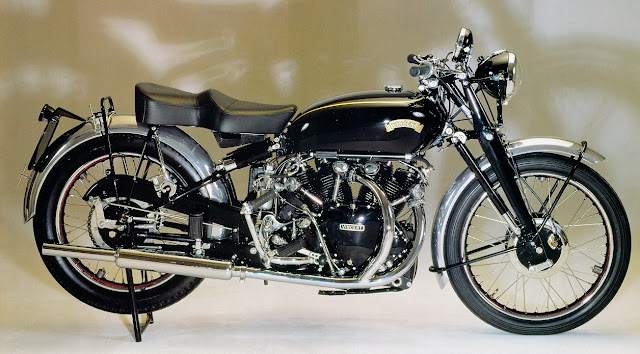The Black Shadow Series C was the fastest bike on the road in the late 1940s and early ’50s, and one of the most stylish.
Sadly for Philip Vincent and his firm, the bike was so expensive to produce that it was not profitable, despite its high price.
Vincent was motorcycling’s greatest name I in the years after the Second World War.
I and the Black Shadow was the firm’s brightest star. With its powerful 998cc V-twin engine and fine-handling chassis, the Shadow was an exotic, superbly crafted and very rapid machine. Its top speed of over 120mph (193km/h) fully justified the advertising line, ‘The World’s Fastest Standard Motorcycle’.
The Black Shadow was a tuned version of Vincent’s Rapide V-twin, itself a magnificent machine. Both models were high-performance roadburners, assembled in small numbers at Vincent’s workshop at Stevenage in Hertfordshire by a small team led by Philip Vincent, the firm’s founder, and Phil Irving, his Australian chief engineer.
Philip Vincent had begun by designing a novel form of sprung motorcycle frame in 1927, while an engineering student at Cambridge University. He left Cambridge and, with backing from his father, set up in business. To give his venture credibility, Vincent bought the name of HRD Motors. The initials were those of Howard Davies, a racer and engineer who had won the 1925 Senior TT on a bike he had built himself, but whose firm had not survived the recession. Vincent kept little of HRD apart from its paint scheme of black with gold trim, but he too intended to produce high-quality, technically innovative bikes.
Early Vincents were powered by proprietary engines from firms including JAP and Rudge. But in 1934 Vincent and Irving were furious when the unreliability of JAP’s ‘special’ racing engines wrecked the firm’s first attempt at the TT. Following their return from the Isle of Man, Irving designed a 499cc single-cylinder engine with an innovative ‘high-camshaft’ layout.
The basic Meteor single and sportier Comet, which was capable of 90mph (145km/h), were a success. They led to the first Rapide V-twin, introduced in 1936, which produced 45bhp from an engine whose cylinders were set at 47 degrees apart. Nicknamed the ‘Snarling Beast’, or ‘plumber’s nightmare’ due to its external oil lines, it was fast but suffered from transmission problems caused by its torque.
Vincent replaced it after the war with the improved Series B Rapide. Its new unit- construction V-twin motor had cylinders at 50 degrees, and formed a stressed member of the chassis, so no downtubes were needed. It combined 1 lOmph (177km/h) top speed with abundant midrange torque, cruised effortlessly at high speed, and handled well. Twin drums on each wheel gave plenty of stopping power.
The tuned Black Shadow, launched in 1948, was faster still. To emphasize its extra performance the Shadow had a large Smiths speedometer calibrated to 150mph (241km/h), and black- finished cylinders and crankcases. A year later Vincent introduced the Series C range, in touring Rapide, sports Black Shadow and racing Black Lightning forms.
Vincents proved their performance worldwide.
In 1949 American ace Rollie Free, riding a tuned Black Lightning, famously stripped to his swimming trunks to set a world record for unsupercharged bikes at 150.313mph (241,89km/h) on the Bonneville salt flats in Utah. Another hero was George Brown, who set speed records and won many sprints on Gunga Din, Nero and the supercharged Super Nero.
Vincent’s problem was that the exotic, hand- built V-twins could not be produced at a profit. The firm struggled during the mid 1950s, and was forced to assemble Firefly engines and NSU lightweight bikes under licence. In 1955 Vincent launched the fully-enclosed Series D models, the Black Knight and tuned Black Prince. But the public was not yet ready for their black fibreglass bodywork, and sales slumped. Revised Rapide and Black Shadow models were reintroduced, but in vain. By the end of the year, Vincent’s mighty beast had snarled its last.
Black finish confirms that this is a Black Shadow engine, in a higher state of tune than the grey unit of the Rapide tourer.
The side view shows off the front girder suspension plus one of the pair of rear shock units, located diagonally beneath the seat.
The fortunate Black Shadow rider was treated to the sight of a big Smiths speedometer that was calibrated to I50mph (241 km/h).
Specification Vincent Black Shadow Series C (1949)
- Engine Air-cooled ohv four-valve pushrod 50-degree V-twin
- Capacity 998cc (84 x 90mm)
- Maximum power 55bhp @ 5700rpm
- Transmission Four-speed, chain final drive
- Frame Steel spine
- Suspension Girder front; twin shocks rear
- Brakes Twin drums front and rear
- Weight 458lb (208kg)
- Top speed 125mph (201 km/h)





















0 comments: